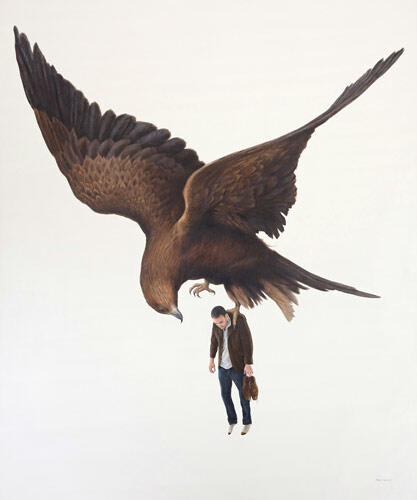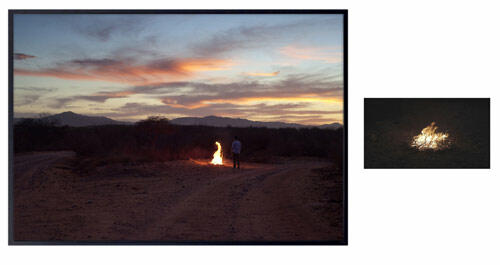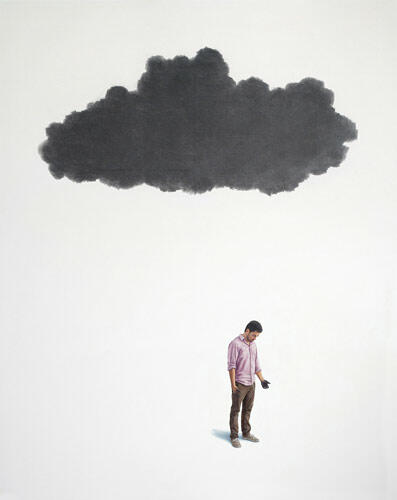Hugo Lugo
Too late, too far
Artist Hugo Lugo’s (Los Mochis, Sin, 1974) most recent exhibition in Mexico opened a few weeks ago at the MASIN (Sinaloa Art Museum), revisiting some of the pieces shown in “La superficie del precipicio” (The Surface of the Precipice) − his first museum solo show exhibited at the Nuevo León Center for the Arts, 2010.

“Demasiado tarde, demasiado lejos” (“Too late, too far”) originates in an anecdote drawn from the Spanish philosopher José Antonio Marina’s book, Anatomía del miedo (Anatomy of Fear). Marina recalls in his text the story of a man who witnessed − from afar − a dramatic accident, and was unable to have any bearing on its outcome precisely because he was “too late, too far.” Lugo decides to make this event the point of departure for his exhibition and follow the museographic thread stringing together works created specifically for this show, which make reference, whether symbolically or literally, to his childhood memories in the sandy Sinaloa territory that gives birth to his native city.
Surprisingly, these new works include a significant production of videos − a medium that has become an increasingly relevant component of the artist’s proposal. The structure method applied in the case of these works, which hold a dialogue with the mobile images, infuses a state of animation in his usual studies and sketches. Thus, the video loops that accompany his photographic work − Ensayar la calma, Ensayar el fulgor, Ensayar el equilibrio/ To rehearse calm, To rehearse brilliance, To rehearse balance – shape up as a promising aspect of the visualnarrative poetics that has earned him international renown.
In some of his polemic writings of the end of the 1990s, Jean Baudrillard advocated the recovery of “radical illusion” in aesthetic creation, proposing a way to achieve this: “You must rip the same from the same” − the French theoretician said − in order to make it disappear, and this disappearance must remain alive in order to harbor, once again, the time of seduction. Some of Lugo’s recent works appear to respond to this invitation.
Let us refer to a boat run aground in one of the exhibition halls. It is the boat on which he crossed the river as a child to visit his two grand-aunts (who raised his father and ran a prosperous ranch on their own, as long as they could); so the artist told me quite a while ago. It is the same boat that only a couple of months earlier he ‘ripped’ from some Sinaloa shore to elaborate on the substance of memory and useless functionality. One of those women died some time ago; her sister is 98 years old. The yearning for those river trips during childhood in the company of his father has become incorporated into that boat. After recovering it, Lugo decided to burn its surface, later to draw on it a skin of infinite graphite strokes composed of the time yielded by the masked body at the moment when the unrecoverable disappears. Lugo illuminates this contextual excerption from within with neonlight letters by means of which he also attempts to deny the sensible bond that many times, against our will, pulls memories out from their deepest hiding places. Just one more of his attempts to match the real with art’s impossibility to replicate and confess, precisely, that endless search for “radical illusion” that artistic practice sometimes succeeds in loosening up in our way of looking.
Ensayar la calma (Rehearse Calm Behavior) shows a frame focused on a patch of sparse reed by a lake with clear water on a limpid daybreak. The surface of the water is moved by calm, nearly invisible waves, almost as if nothing was happening. Lugo’s rehearsal takes place in a discreet but insistent fashion. However, how can calm be practiced or rehearsed?What does he expect from this attempt? To one side, a large-scale photograph shows a panoramic view of the lake with a thin stretch of land jutting halfway through it towards the center; on it, a standing man stares into the same nothingness.
Another of Lugo’s photography/video accompaniments concerns itself with brilliance and shows a small fire, carefully enclosed inside a circle of stones in some unobstructed landscape. The amplified photograph responds to the small fire featuring a splendid sunset. Once again, the question concerning what is “rehearsable” − on this occasion, about fire and the enjoyment of fire − resurges. Lugo chooses to rehearse those things that do not necessarily depend on our ability, potential or disposition. His following the flight of a flock of buzzards that maintain a vigilant surveillance on our equally transient existence (Recordar el trayecto/ Remember the route); or his seeking to draw the wanderings and errors of his strokes, against a contrasting sky background, respond to the same old-fashioned, romantic impulse that has shaped Lugo’s artistic process from the beginning of his career. That same impulse that led him, some years ago, to rehearse on the constellations drawing star doodles, or to capture in a little box the stellar darkness conjured in a visit to a nocturnal museum; it is that helpless impulse that makes him build defenseless boats − capable, however, of ignoring the imminent thaw about to take place behind them − to host the recreation of some idle couple. What Hugo Lugo offers us in this exhibition is that “behind” that animates the questions about calm and brilliance − that “behind” the rehearsal, the foresight, the trace in the gaze, unveiling the future of his present path. We will certainly see him exercise the aspects of interaction offered to his subjects by the displayed temporality of these new mobile-landscapes. For although there would seem to be some element of discipline in his process that does not allow him to distance himself from the certain seduction of his works in oil or his gouaches, this will possibly be the signature style that Lugo will appropriate to haunt the interstices between mediums, formats and resolutions, in order to see beyond the calm confines of the frame, the brightness of the screen, and the
encoded temporality of the stroke; to continue seeing that which lies behind disappointment.
“Too late, too far” may well be read as a preview of the interdisciplinary dialogic trail that the latest (or first?) consequences of Lugo’s work promise to tread in the next few years.
-
 Evocar una canción (separator), 2011. Acrylic and oil on canvas, 70.8 x 59 in. Courtesy Ginocchio Gallery. Acrílico y óleo s/tela, 180 x150 cm. Cortesía Galería Ginocchio.
Evocar una canción (separator), 2011. Acrylic and oil on canvas, 70.8 x 59 in. Courtesy Ginocchio Gallery. Acrílico y óleo s/tela, 180 x150 cm. Cortesía Galería Ginocchio. -
 Ensayar el fulgor, 2011. Diptych. HD digital print + video loop (fire close-up), 43.3 x 63 in. and DVD projector with audio 1/3. Courtesy Ginocchio Gallery. Díptico. Impresión digital alta calidad + loop de video (close up fogata). 110 x160 cm. y reproductor DVD con audio 1/3. Cortesía Galería Ginocchio.
Ensayar el fulgor, 2011. Diptych. HD digital print + video loop (fire close-up), 43.3 x 63 in. and DVD projector with audio 1/3. Courtesy Ginocchio Gallery. Díptico. Impresión digital alta calidad + loop de video (close up fogata). 110 x160 cm. y reproductor DVD con audio 1/3. Cortesía Galería Ginocchio. -
 Forma de correspondencia 2, 2011. Diptych. Graphite on cotton paper and bird feather covered with graphite, 50 x 37.4 in. Courtesy Ginocchio Gallery. Díptico. Grafito s/papel algodón y pluma de ave cubierta de grafito, 127 x 95 cm. Cortesía Galería Ginocchio.
Forma de correspondencia 2, 2011. Diptych. Graphite on cotton paper and bird feather covered with graphite, 50 x 37.4 in. Courtesy Ginocchio Gallery. Díptico. Grafito s/papel algodón y pluma de ave cubierta de grafito, 127 x 95 cm. Cortesía Galería Ginocchio. -
 Reconocer la tormenta, 2011. Oil and graphite on canvas, 63 x 51 in. Courtesy Ginocchio Gallery. Óleo y grafito s/tela, 160 x130 cm. Cortesía Galería Ginocchio.
Reconocer la tormenta, 2011. Oil and graphite on canvas, 63 x 51 in. Courtesy Ginocchio Gallery. Óleo y grafito s/tela, 160 x130 cm. Cortesía Galería Ginocchio.




